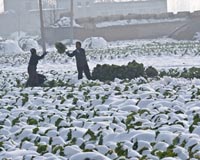| . |  |
. |
Colombo (AFP) July 19, 2010 Six countries seen as most threatened by rising sea levels have vowed to cut their carbon emissions as a gesture of their commitment to fight global warming, the Maldivian government said Monday. The countries, mostly low-lying nations, met over the weekend in the Maldives ahead of a UN climate change meeting in Mexico and pledged to drastically cut their emissions while pressing others to follow suit. "Antigua and Barbuda, Costa Rica, Ethiopia, the Maldives, the Marshall Islands and Samoa all pledged to slash greenhouse gas emissions and pursue green growth and development," the government said in a statement. The Maldives, which wants to be carbon-neutral by 2020, is one of the most vulnerable countries to a rise in sea levels because its low-lying islands and atolls would be submerged. Ethiopia hopes to be carbon neutral by 2025, while the Marshall Islands has pledged to cut emissions by 40 percent by 2020, and Antigua and Barbuda by 25 percent. Costa Rica plans to go carbon neutral by 2021. Being carbon neutral means offsetting emissions against other measures that help to reduce greenhouse gases in the atmosphere. "When those with the least start doing the most, it shows that everyone's ambitions can be raised," Maldivian President Mohamed Nasheed said in the statement after the weekend meeting. Smaller nations are trying to hammer out a common position before the UN climate meeting in Mexico scheduled to open on November 29. The 10-day meeting is set to revisit the issues of global warming after talks at December's Copenhagen summit fell short of a binding international treaty.
earlier related report Climate scientists at Texas Tech University have issued a report of advice and recommendations for possible outcomes of choosing future emissions targets, a university release said Friday. "Many of us have had the experience of going to the doctor and receiving advice on how to improve our health," climate researcher Katherine Hayhoe said. "Then, it's up to us to decide how much we are willing to change," Hayhoe said. "In a similar way, this report presents the probabilities of certain impacts at different levels of global temperature increase." The report estimates changes in precipitation, stream flow, wildfires, crop yields and sea level rise that can be expected with different degrees of greenhouse gas warming. "We, the scientists, can't make the decisions of how much risk is acceptable," Hayhoe said. "That's a political decision. Rather, we're trying to give policymakers the information they need to make these decisions."
Share This Article With Planet Earth
Related Links Climate Science News - Modeling, Mitigation Adaptation
 China's wars, rebellions driven by climate: study
China's wars, rebellions driven by climate: studyParis (AFP) July 14, 2010 Two millennia of foreign invasions and internal wars in China were driven more by cooling climate than by feudalism, class struggle or bad government, a bold study released Wednesday argued. Food shortages severe enough to spark civil turmoil or force hordes of starving nomads to swoop down from the Mongolian steppes were consistently linked to long periods of colder weather, the study found ... read more |
|
| The content herein, unless otherwise known to be public domain, are Copyright 1995-2010 - SpaceDaily. AFP and UPI Wire Stories are copyright Agence France-Presse and United Press International. ESA Portal Reports are copyright European Space Agency. All NASA sourced material is public domain. Additional copyrights may apply in whole or part to other bona fide parties. Advertising does not imply endorsement,agreement or approval of any opinions, statements or information provided by SpaceDaily on any Web page published or hosted by SpaceDaily. Privacy Statement |